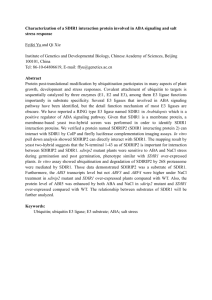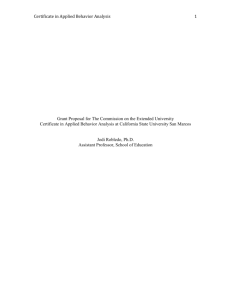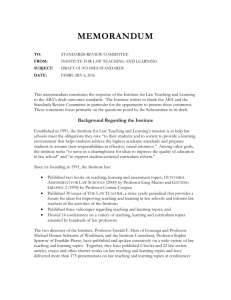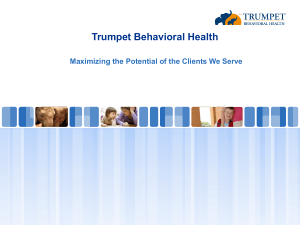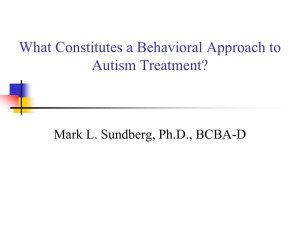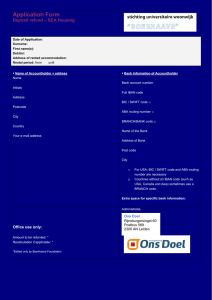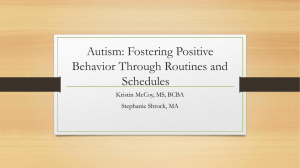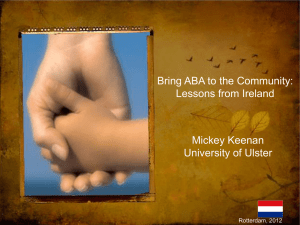Introduction to Applied Behavior Analysis Script
advertisement
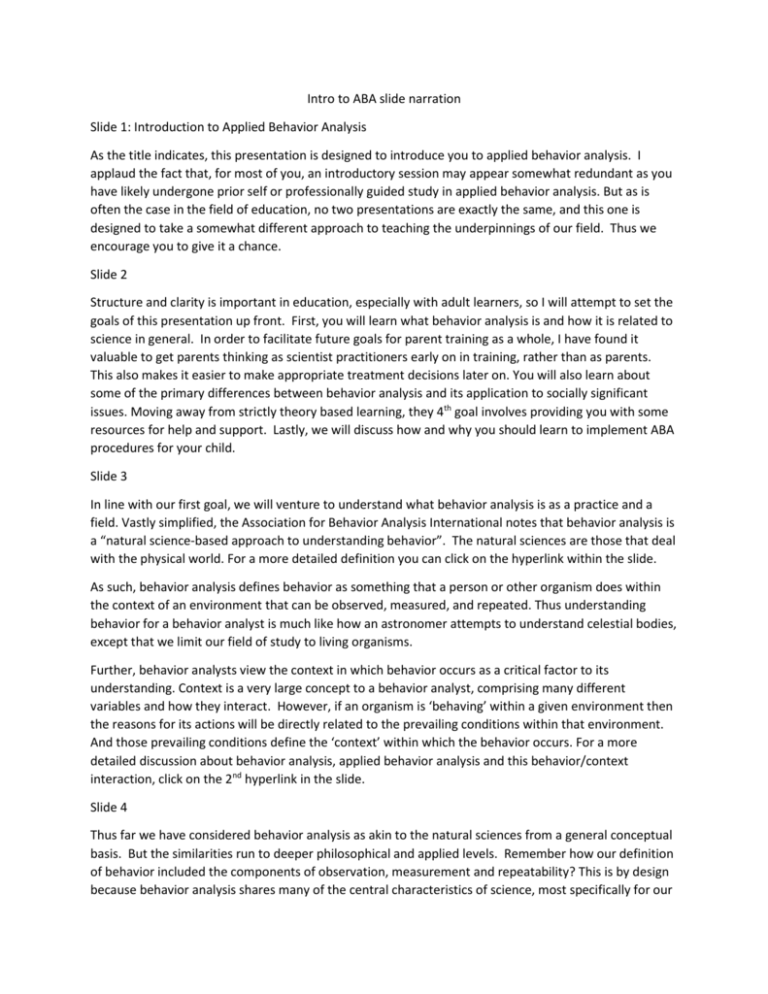
Intro to ABA slide narration Slide 1: Introduction to Applied Behavior Analysis As the title indicates, this presentation is designed to introduce you to applied behavior analysis. I applaud the fact that, for most of you, an introductory session may appear somewhat redundant as you have likely undergone prior self or professionally guided study in applied behavior analysis. But as is often the case in the field of education, no two presentations are exactly the same, and this one is designed to take a somewhat different approach to teaching the underpinnings of our field. Thus we encourage you to give it a chance. Slide 2 Structure and clarity is important in education, especially with adult learners, so I will attempt to set the goals of this presentation up front. First, you will learn what behavior analysis is and how it is related to science in general. In order to facilitate future goals for parent training as a whole, I have found it valuable to get parents thinking as scientist practitioners early on in training, rather than as parents. This also makes it easier to make appropriate treatment decisions later on. You will also learn about some of the primary differences between behavior analysis and its application to socially significant issues. Moving away from strictly theory based learning, they 4th goal involves providing you with some resources for help and support. Lastly, we will discuss how and why you should learn to implement ABA procedures for your child. Slide 3 In line with our first goal, we will venture to understand what behavior analysis is as a practice and a field. Vastly simplified, the Association for Behavior Analysis International notes that behavior analysis is a “natural science-based approach to understanding behavior”. The natural sciences are those that deal with the physical world. For a more detailed definition you can click on the hyperlink within the slide. As such, behavior analysis defines behavior as something that a person or other organism does within the context of an environment that can be observed, measured, and repeated. Thus understanding behavior for a behavior analyst is much like how an astronomer attempts to understand celestial bodies, except that we limit our field of study to living organisms. Further, behavior analysts view the context in which behavior occurs as a critical factor to its understanding. Context is a very large concept to a behavior analyst, comprising many different variables and how they interact. However, if an organism is ‘behaving’ within a given environment then the reasons for its actions will be directly related to the prevailing conditions within that environment. And those prevailing conditions define the ‘context’ within which the behavior occurs. For a more detailed discussion about behavior analysis, applied behavior analysis and this behavior/context interaction, click on the 2nd hyperlink in the slide. Slide 4 Thus far we have considered behavior analysis as akin to the natural sciences from a general conceptual basis. But the similarities run to deeper philosophical and applied levels. Remember how our definition of behavior included the components of observation, measurement and repeatability? This is by design because behavior analysis shares many of the central characteristics of science, most specifically for our purposes, description, explanation, prediction and control. We operationally define behavior in observable and measurable terms so we can clearly note its presence and absence. We then observe behavior occurring in a given context and make note of the environmental conditions occurring before and after in an attempt to identify the processes responsible for it. We attempt to explain these processes in their most basic terms and manipulate them experimentally in an attempt to establish conditions under which we can cause a given behavior to happen or not happen. Lastly, we repeat this process to establish an adequate degree of certainty that the change was a result of our manipulations and not other factors such as chance. Please click the hyperlink for a more detailed discussion of these scientific characteristics. Slide 5 Who best to describe behavior analysis and its origins than one of its founding fathers, BF Skinner? This video is provided free of charge by the BF Skinner Foundation. While rather lengthy at 45 minutes, it clarifies very well the concepts presented thus far in this presentation. Feel free to watch the video in segments if the full 45 minutes proves a bit too challenging. Enjoy! Slide 6 In previous slides, you read some information on the web about behavior analysis and some of the things that make it different from applied behavior analysis. In an effort to avoid redundancy, the contents of this slide will focus primarily on what sets ABA apart not only from behavior analysis but from psychology as well. In 1968, Trevor Stokes and Donald Baer wrote an article entitled “Some Current Dimensions of Applied Behavior Analysis” for the inaugural issue of the Journal of Applied Behavior Analysis. In this seminal work, Stokes and Baer outlined 7 dimensions that Applied Behavior Analysis must possess as a field; these dimensions still hold true today. The first of these, “applied” could perhaps, be considered the ‘mission statement’ or the social conscience for the field. It specifies the application of behavior analytic technology to changing behavior that is socially significant first and foremost. After all, any technology that is to be considered seriously by mainstream society must possess pragmatic value for its consumers, otherwise it is cast aside and considered unnecessary. The next several dimensions attach ABA to its natural science roots. Behavioral ensures the requirement that the unit of study, namely behavior, is clearly defined, observable and measurable. This ensures precision when examining phenomena and discussing results. Stokes and Baer also reasoned that ABA must be conceptually systematic to ensure longitudinal growth of the field and its research base. Any truly novel findings should be presented heuristically and invited for scrutiny in peer reviewed literature. Along with being systematic ABA procedures must meet a requirement of being technological, possessing procedural descriptions and are clear, concise. This way, other practitioners in the field can replicate find ings to determine if they are consistent or spurious. Maintaining adherence to the technological dimensions also facilitates clarity when determining the processes responsible for behavior change. Perhaps the dimension that best separates ABA from conventional psychology is its analytic dimension. ABA resists ascribing changes in behavior to hypothetical constructs and bases all determinations and decisions on data, most typically, rate of behavior. Relying on data to guide decision making also ensures unbiased interpretation of results and adherence to the other 6 dimensions. The final two dimensions reattach to the first in terms of social significance. ABA must be effective in acting as an agent for behavior change; otherwise it fails to produce acceptable levels of social validity. For example, which doctor would you see if you had a knee problem – one who has an excellent track record of treating and rehabilitating patients or one who doesn’t? Lastly, ABA must ensure generality, not only of behavior change but the external validity of the techniques and procedures in its research base. Portability of individual behavior change goes a long way toward ensuring the independence of ABA’s recipients and increasing their overall quality of life. However, if those results were only applicable to a specific clientele or under highly specific circumstances, the field would be seriously marginalized. While a vibrant field can have multiple areas of specialty (such as with specialist medical practitioners), the field as a whole must have widespread application, to widespread socially significant issues. Slide 7 In comparison to other fields, ABA is still in its infancy. Because growth has been steady, the past two decades or so has established the need to exert quality control over practitioners to ensure continued service provision by competent professionals. In response, a group of behavior analysts led by the late Jerry Shook formed the Behavior Analyst Certification Board in 1998. In short, the mission of the BACB was to establish minimum competency standards for behavior analysts across educational levels, help training programs meet minimum educational requirements to prepare behavior analysts adequately and to set different credentialing levels and requirements as per education and experience. As such, the BACB established 4 different certification levels, BCBA-D, BCBA, BCaBA and most recently RBT. For more information on the BACB, its credentialing process, ethical or disciplinary standards or practitioner guidelines, you can visit their website by clicking on the hyperlink provided in the slide. There are also many other organizations who support ABA from which you can get information. Autism NJ (formerly COSAC) provides guidance to families on issues related directly to autism spectrum disorders. Their website, which is accessible from the hyperlink in the slide, contains a wealth of information for parents and professionals alike on topics such as autism diagnosis, early intervention resources, the Individualized Education Plan process and navigation of the newly introduced NJ Autism Insurance Bill. NJ Autism also sponsors a very large conference each year in Atlantic City with days geared toward professionals and parents specifically. Lastly, the Association for Science in Autism Treatment (or ASAT) is an organization forwarding the dissemination of evidence-based practices in ASD treatments. Their website, which can also be reached via hyperlink in the slide, is a treasure trove of the most current information regarding interventions for ASDs and can provide some much needed guidance for families when deciding how to help their children. Slide 8 With the introduction of the NJ Autism Insurance Act of 2009, families finally gained access to autism services provided or reimbursed by federal and state funded insurance companies. However, much like the other services for which they provided reimbursement, insurance companies expressed concern about the regulatory mechanisms establishing qualifications of the individuals providing these services, particularly those implementing ABA programs. Fortunately the BACB stepped in and the insurance companies accepted both its credentialing system and its practice parameters. Although in need of further development, the insurance companies are now beginning to agree upon standardized billing processes and procedural coding for autism-specific services. Further, most have established provider networks throughout New Jersey and other states. Should you have questions about how to secure services or where to find them, you should ask your insurance company or visit the sites provided on the previous slide. Slide 9 In an effort to help you, the families, understand the roles and responsibilities of ABA practitioners, this slide outlines the basic practice parameters for the various credentialing levels of the BACB. In terms of scope of practice, the BCBA-D and BCBA credentials are essentially equal, although the BCBA-D credential signifies doctoral level training while the BCBA credential specifies at least master’s level. As can be seen in the slide, the BCBAs and BCBA-Ds function as program supervisors and, as such have the least amount of direct contact with the client, typically 2-4 hours per month. Their interaction with your child is typically limited to assessment in the form of skill and functional behavioral assessments. However they can also provide training for parents and, in the process, model behavioral techniques with your child. BCaBA practitioners must secure regular supervision by a BCBA or BCBA-D and in doing so, can provide some program oversight, direct implementation and perform portions of functional behavioral assessments. But the BCaBA’s role in a given home program can vary, depending upon your insurance provider’s policies and those of the ABA provider delivering services. Registered Behavioral Technicians or RBT practitioners are direct implementation staff that have 40 hours of ABA training and must be supervised directly by a BCaBA or above. These are the individuals who will provide the bulk of the direct contact hours with your child. Should you have any further questions about the credentialing levels or see further information, please visit the Board’s website. Slide 10 Perhaps alternate titles for this slide could be “Should I do this with my child?” or “Do I have to do this with my child?”, and the answer to both questions is an unequivocal YES! The reasons for this are numerous; but most importantly, by becoming proficient in ABA techniques you can supplement your child’s time in school by teaching at home, which is directly and positively correlated with improved outcomes in all skill sets across the board. Increased practice means faster learning and increased practice in settings other than school means deeper understanding and more ‘portable’ skills for your child. Although the skill sets you teach at home can be the same as those in school, you may opt to target only those that serve your family best at home, such as hygiene, daily routines, leisure and community access to name a few. If you think about it, who better to identify these areas and pick targets than the people who are with your child the most during these situations? Click on the hyperlink to see a family working as part of a treatment team to teach their child with autism as an example. Slide 11 Buying into the idea of something is vastly different from actually doing it, so the next few slides will discuss Allegro’s model for parent training and how you can start your own education with some help from us. Our model is to empower families for the reasons stated previously, and we achieve this according to 4 basic themes which, based on our experience and the available research base, enables training to be both comprehensive and efficient. These themes are didactic training in basic behavior analytic content, behavior skills training to learn the techniques, general case study to ensure ‘loose’ learning and generalizability of skills and lastly adoption of an adult learner model to ensure a curriculum and delivery system that meet your and your family’s needs. Each of these themes will be discussed in the next few slides. Slide 12 When referring to didactic training within our model, we imply some form of study into the curricular content on which our training is based. Of course for our purposes, this means developing firm foundational knowledge in behavior analytic and applied BA philosophies, terms and processes. So we summarize information drawn from peer reviewed literature and present it to parents in the form of presentations, hyperlinks to websites and supplementary materials such as handouts and information packets. Although we specify foundational knowledge as our curricular focus primarily, we encourage parents to delve deeper into some of the concepts through conferences, online seminars and other sources based on their personal interests and needs. However, we must offer a word of caution regarding the validity of information obtained through online chatrooms, specialty discussion forums and other non-peer reviewed sources. As with many sources on the internet, these can be used as vehicles for unsubstantiated claims, misinterpretation of valid information or blatant marketing of personal products which, while sounding perfectly legitimate, can actually work against the goals you and we are trying to achieve. Should you have any questions about where to find valid information about behavior analysis or questions about information you may have found already, just ask - we will be happy to answer them! Slide 13 While a strong knowledge base is critical for understanding why you may implement a given set of behavioral techniques, that information is useless if you do not learn how to implement the techniques. The ABA research base shows us that behavior skills training or BST is an effective technique to translate knowledge into practice, especially with adult learners. BST is comprised primarily of 4 basic components – instructions, modeling, rehearsal and feedback. Instructions consist of verbal or written directions about how to perform a given skill or technique. Research demonstrates that the most effective way to present instruction is to break a target skill into its component parts using a technique called task analysis. Thus in many cases, you will receive instructions as a list of steps to follow. Using steps enables you to recognize each part of the sequence discretely which, in turn, allows the instructor great precision in teaching them. Once familiar with the steps, you will watch the instructor model the skill, first in a role play with you and then with your child. In the rehearsal component, it is your turn to perform the skill, again first during a role play with your instructor and then with your child. While rehearsing the skill, the instructor will deliver specific performance feedback to you, based on the steps listed in the instructions. Feedback may be verbal, where the instructor tells you what you did correctly and incorrectly, written in the form of a performance checklist or a combination of the two. During the feedback phase, the instructor may choose to address performance deficits through additional role play or at the point of performance while you are interacting with your child. Slide 14 For those of you interested in reading research, here are just a few of the many studies that support the use of BST with adult learners. Slide 15 Continuing toward the goal of family empowerment, we strive to give parents skills that they can use across many different situations. The specificity of BST as described in the prior slide allows us to train you to a high degree of precision and confidence in implementing many different but specific behavioral techniques. However, for a moment, envision ABA skills in the context of a toolbox; the tool or technique you choose depends on the job for which you will use it. For most situations, you can get by with just a few basic tools in your toolbox because some tools can serve multiple purposes. However, the more complex and specific the problem, the more specific the tool needed and the more skills-based training in using the tool required. To keep the analogy going, general case programming deals with teaching you how and when to choose a tool by identifying the range of situations in which that tool might be used, selecting several situations that are representative of the range and teaching you the variations on target skills to be used within them. All of this is done so you can respond to novel situations in which you can use the tool. Procedurally, ABA techniques tend to fall into categorical frameworks and, as such, lend themselves to application across a wide variety of situations that share common features such as treatment outcome or behavioral function. For example, mand training involves teaching a child how to request items based on her wants and needs. While the concept and theme of adaptive communication remains constant, the specific response form can vary from vocal communication to say picture exchange or the context can vary from requesting food items to requesting use of the bathroom. If applying general case programming to this example, you would learn to apply mand training techniques across a variety of situations so that you learn not only HOW to perform the procedures but WHEN to use them. Hopefully you can now see how didactic and behavior skills training fit in with general case programming. Should you be interested, the hyperlink in the slide brings you to one of the seminal articles establishing general case programming as a valid behavioral technique. Slide 16 The final dimension of our parent training model is, not coincidentally, the one that binds the other three together. Teaching you through an adult learner model establishes the validity of our training components and content because it accounts for your needs and preferences in designing and implementing the training curriculum. In short, adult learner models are adaptive. Adults want to learn things that improve their quality of life and learn best when theory is translated into practice during situations that are important to them. Thus, adults learn information through the lens of how they intend to apply it. Take for example, your reasoning for viewing this presentation versus those for which a college student would view it. Undoubtedly, the issues you face with your child on the autism spectrum establish both your goals for training and process by which it must occur. So adopting a model that incorporates both of these training dimensions ensures that curriculum content is applied directly to the issues you are facing, in a manner that prepares you to address future issues efficiently and effectively. Once you inform us of your priorities we can design a training curriculum that is based on your personal needs and will help you meet your goals as efficiently as possible.

